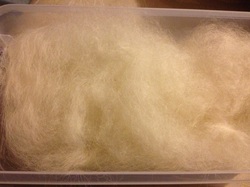http://www.bbc.com/news/entertainment-arts-26381340
|
It looks like there will be a film tour of the Viking exhibit that opens March 6 in London. Might be a great way to view the museum's offerings (in addition to ordering the exhibit catalog).
http://www.bbc.com/news/entertainment-arts-26381340
0 Comments
My choice for this month is a blog called Loose Threads. It is run by a woman named Cathy who produces posts that not only well-written and well-cited, but who is very clear in explanation of her thought processes on exactly why she chooses to do things a certain way.
I originally found her site when researching Viking garb, but she covers a good many other areas as well. And she is great about posting new articles and other resources as she finds them. I very much recommend grabbing a cup of tea and taking a few hours to leisurely stroll through her work. http://cathyscostumeblog.blogspot.com/  Combed wool. Combed wool. I excited to finally get this project underway! I had intended to start it in the fall, but the vendor I was hoping to buy fleece from disappeared on me. I found another white Icelandic fleece in December and finally got it washed last week and started combing a portion of it this past weekend. I am curious to see how different fabric looks when dyed at different stages in the textile creation process. At Coppergate wool was found that was dyed in the fleece with madder (Walton, 1713) and some of the tabbies from the Oseberg ship burial were dyed after the cloth was woven (Ingstad). This got me thinking about how garments that are dyed in the wool, yarn-dyed or dyed after weaving would differ in final appearance and feel. So now I have a fleece which is cleaned and separated into 3 equal portions (of about 7oz each) which I will process and dye. One sample will be dyed in the fleece, spun and then woven. The next will be spun into yarn, dyed and then woven. The last will be spun, woven and then the resulting fabric swatch will be dyed. All wool will be combed prior to spinning and all samples will be woven on a rigid heddle loom. The dye will be madder and all samples will be dyed at once (with locks, yarn and fabric going into the same dyebath to insure consistency). I hope this goes well as I look forward to seeing how the results compare. Resources
Ingstad, Anne Stein. "The Textiles in the Oseberg Ship". http://forest.gen.nz/Medieval/articles/Oseberg/textiles/TEXTILE.HTM Walton, P. "Textile Production at 16-22 Coppergate." The Archaeology of York Volume 17: The Small Finds. 1977. |
About Me
I am mother to a billion cats and am on journey to recreate the past via costume, textiles, culture and food. A Wandering Elf participates in the Amazon Associates program and a small commission is earned on qualifying purchases.
Archives
July 2024
Categories
All
Blogroll of SCA & Costume Bloggers
Below is a collection of some of my favorite places online to look for SCA and historic costuming information.
More Amie Sparrow - 16th Century German Costuming Gianetta Veronese - SCA and Costuming Blog Grazia Morgano - 16th Century A&S Mistress Sahra -Dress From Medieval Turku Hibernaatiopesäke Loose Threads: Cathy's Costume Blog Mistress Mathilde Bourrette - By My Measure: 14th and 15th Century Costuming More than Cod: Exploring Medieval Norway |

 RSS Feed
RSS Feed